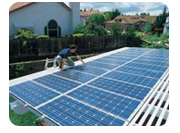Tools for Local Governments
Funding
Amortizing Costs
A new technique has recently come to light for removing the barriers to entry of energy-efficient and renewable energy technologies. Local governments can purchase upgrades such as energy-efficient devices and solar panels for residential and commercial buildings and then amortize the cost over time, paying for these upgrades with surplus revenue generated through a revised property tax. Citizens and businesses can use the cost savings generated by the drop in their energy bill to cover the cost of the revised property tax. The City of Berkeley has decided to use this financing technique to help citizens realize savings on their energy bill and to help fight climate change.
Funding Energy-Efficient Technologies with Fiscal Savings of Conservation

Bill Clinton addresses U.S. mayors at the Climate Protection Summit in Seattle (Photo: U.S. Conference of Mayors)
As local governments embark on energy conservation programs, they can use the monetary savings generated by these programs to fund invetsment in new energy-efficient technologies. As the movement to mitigate climate change gains momentum, large discounts on energy-efficient technologies are becoming available. For example, the Clinton Climate Iniative will be offering deep discounts on energy-efficient technologies for cities throughout the United States. Products with discounts will include energy-efficient indoor lighting, traffic and street lighting, building products, water system components, alternative energy technologies, clean vehicles and advanced waste management technologies. These and other products will be offered by 25 manufacturers to municipal governments at discounted prices ranging from 5% to 15% below current levels for commodity items and from 15% to 70% below current levels for non-commodity items.
Other Funding Options
The following list represents a few of the funding options available to local governments for energy-efficiency projects:



